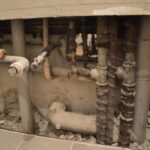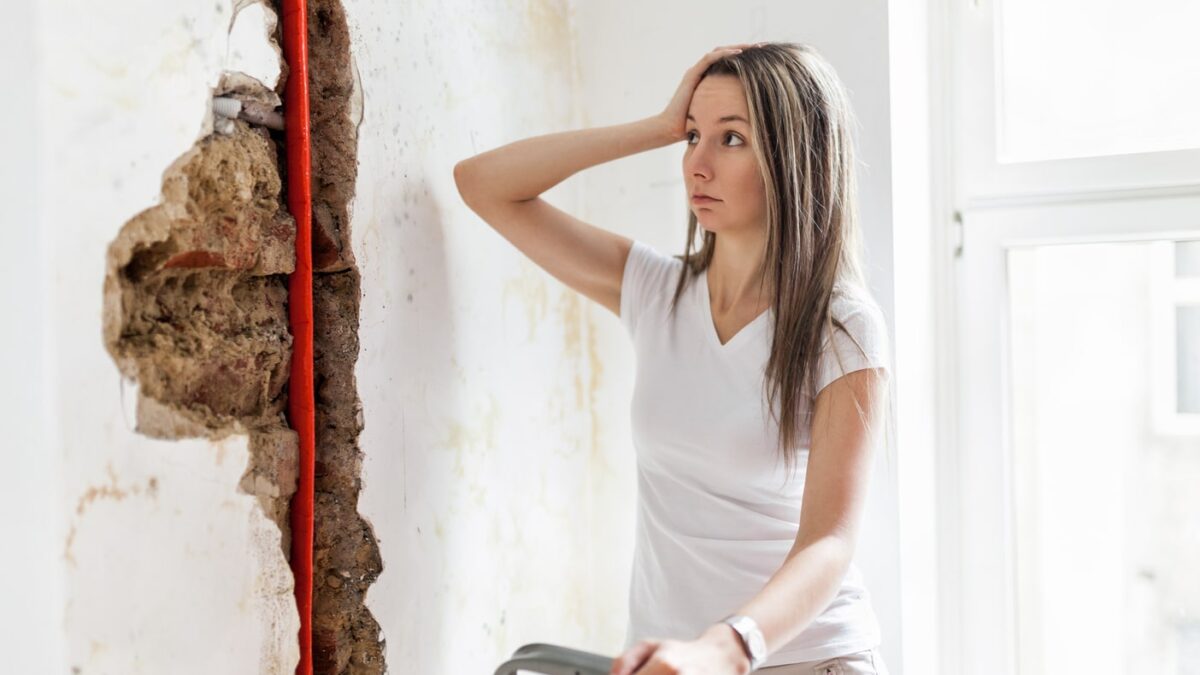
Navigating Plumbing Issues: Why Your Faucet May Not Turn Off and How to Address It.
November 29, 2023
Tips for Fixing a Humming Garbage Disposal
December 27, 2023Are you facing the frustrating issue of a hidden water leak in your home or business? Leaks under concrete floors can be a major concern, causing damage and high water bills. But don’t worry, with the expertise of Babe’s Plumbing, Inc. & Fire Sprinklers in Venice, Florida, we can help you detect and fix these hidden leaks.
What Are the Signs of Hidden Water Leaks?
Hidden water leaks can cause significant damage if left undetected. As a homeowner, it is important to be aware of the signs that may indicate a hidden water leak in your home. In this section, we will discuss the various signs of hidden water leaks, including an unusual increase in your water bill, musty odors, mold growth, and water stains on walls or ceilings. By knowing what to look out for, you can catch a potential leak early and prevent costly repairs.
1. Unusual Increase in Water Bill
- Be sure to check for any unusual increase in your water bill compared to previous months.
- Monitor your water usage patterns to identify any sudden spikes in consumption.
- Inspect all water fixtures and pipes for leaks or drips that could contribute to the increase.
- If no visible leaks are found, it may be beneficial to hire a professional plumber to conduct a thorough inspection.
2. Musty Odors
Musty odors are often a tell-tale sign of hidden water leaks, which can lead to the growth of mold or mildew. If you detect a musty smell, it is important to thoroughly inspect your property for any potential leaks. It is crucial to promptly address any underlying water leaks to prevent further damage and potential health risks.
Consider seeking the assistance of a professional plumber to conduct a comprehensive inspection and effectively resolve the issue.
3. Mold Growth
- To hinder mold growth, it is important to keep indoor humidity levels below 60%.
- Proper ventilation in bathrooms and kitchens is essential in preventing mold growth.
- Promptly address any water leaks or moisture issues to prevent mold growth.
- In areas prone to dampness, use mold-resistant products to hinder the growth of mold.
4. Water Stains on Walls or Ceilings
- Identify the Source: Investigate the specific location of the water stains on walls or ceilings to pinpoint the source of the leak.
- Inspect Plumbing: Check for damaged, deteriorated, or clogged pipes or fittings that may be causing the water stains on walls or ceilings.
- Assess Roof and Gutters: Examine the roof and gutters for any damage or blockage that could lead to water seepage and result in stains on walls or ceilings.
- Check External Walls: Look for cracks or gaps in the external walls that could allow water to penetrate and cause unsightly stains on walls or ceilings.
- Consult Professionals: Seek assistance from plumbers or water damage specialists to effectively address and rectify the issue of water stains on walls or ceilings.
How to Find Water Pipes Under Concrete Floors?
As a homeowner or property owner, it is important to be able to detect hidden water leaks, especially those that may be lurking under your concrete floors. In this section, we will discuss various methods for finding water pipes under concrete floors. From using a pipe locator to hiring a professional plumber, we will cover the most effective techniques for locating these hidden pipes. By the end, you will have a better understanding of how to detect and prevent potential water leaks in your home or property.
1. Use a Pipe Locator
- Conduct research on the area to determine the most likely locations of the pipes.
- Utilize a pipe locator device to accurately detect the precise position of the water pipes.
- Adhere to the manufacturer’s instructions for operating the pipe locator device.
- Scan the concrete floor with the locator to trace the route of the pipes.
- Note and label the positions of the pipes for future reference.
2. Look for Visible Pipes
- Inspect the areas where pipes are typically visible, such as the basement, crawl spaces, or utility rooms.
- Look for exposed pipes in these areas and check for any signs of corrosion, rust, or moisture.
- Use a flashlight to examine the pipes closely, paying attention to any discoloration or water droplets.
- If you notice any issues, immediately contact a professional plumber to assess and repair the visible pipes.
Remember, regularly checking for visible pipes can help you detect potential leaks early, preventing extensive damage and costly repairs.
3. Use a Thermal Imaging Camera
- Prepare the thermal imaging camera by ensuring it’s fully charged and set to the appropriate sensitivity level.
- Start scanning the concrete floor, focusing on areas where water pipes are most likely to be located, such as near utility entry points or bathroom/kitchen fixtures.
- Use the thermal imaging camera to look for temperature variations or anomalies that could indicate the presence of a hidden water leak.
- Document any suspicious findings and consult with a professional plumber or leak detection specialist for further investigation and resolution.
4. Hire a Professional Plumber
- Check Credentials: Look for licensed and insured professionals for the job of hiring a professional plumber.
- Experience Matters: Prioritize plumbers with extensive experience in detecting and repairing hidden water leaks.
- Request Make sure to hire a professional plumber with the necessary credentials and experience to handle the job.
What Are the Risks of Ignoring Hidden Water Leaks?
Ignoring hidden water leaks can have serious consequences that extend beyond just a higher water bill. In this section, we will discuss the various risks associated with disregarding or delaying repairs for hidden water leaks. From potential structural damage to health risks, we will explore the dangers of neglecting the signs of a leak. Additionally, we will touch on the financial implications of wasted water and how it can lead to higher bills if left unchecked.
1. Structural Damage
- Regularly inspect the foundation, walls, and ceilings for any signs of water damage, such as discoloration, warping, or soft spots.
- Monitor water bills for any unexplained increases, which can indicate hidden leaks causing structural damage.
- Address any plumbing issues immediately to prevent long-term structural damage and costly repairs.
A homeowner ignored a musty odor for months, resulting in extensive structural damage and mold growth, leading to hefty repair expenses.
2. Mold Growth and Health Risks
- Inspecting for mold growth in damp areas like basements and bathrooms to prevent potential health risks.
- Addressing any water leaks promptly to prevent moisture accumulation and the formation of mold.
- Seeking professional assistance for mold remediation if extensive growth is detected and to ensure the health and safety of individuals.
3. Wasted Water and Higher Bills
To avoid the consequences of wasted water and higher bills, it’s essential to stay vigilant and proactive in identifying and addressing any water leaks or plumbing issues promptly.
- Regularly inspect plumbing and fixtures to identify and fix any leaks promptly.
- Monitor water usage by keeping track of your water bills and usage to detect any unexplained increases.
- Address any leaks or issues immediately to prevent wasted water and higher bills.
How to Prevent Hidden Water Leaks?
Hidden water leaks can cause significant damage to your home and lead to costly repairs. In this section, we will discuss how you can prevent these leaks from occurring in the first place. By regularly inspecting your plumbing and fixtures, monitoring your water usage, and addressing any leaks or issues immediately, you can minimize the risk of hidden water leaks and protect your home from potential damage. Let’s dive into each of these preventative measures and learn how they can help you avoid the headache of dealing with hidden water leaks.
1. Regularly Inspect Plumbing and Fixtures
- Regularly check for any visible leaks, water stains, or corrosion on plumbing fixtures.
- Inspect pipes for any signs of damage, such as rust, cracks, or deterioration.
- Regularly test faucets, showers, and toilets for any unusual drips or leaks.
- Monitor water pressure to ensure it falls within the normal range, indicating proper plumbing function.
2. Monitor Water Usage
- Track water meter readings regularly to monitor usage.
- Investigate any unexplained spikes in water consumption.
- Use smart water meters to receive real-time usage data.
- Implement water-saving practices, such as fixing leaks and using water-efficient appliances.
To effectively keep track of water usage, it is important to stay vigilant and proactive in identifying and addressing any irregularities or inefficiencies in water consumption.
3. Address Any Leaks or Issues Immediately
- Assess and Identify: Regularly inspect plumbing, fixtures, and surrounding areas for any signs of leaks or water damage.
- Act Promptly: Upon detection of any leaks or issues, address them immediately to prevent further damage or potential health risks.
- Seek Professional Help: If unable to resolve the issue independently, consult a professional plumber to assess and fix the problem efficiently.
- Maintain Vigilance: Monitor water usage and bills regularly to detect any unusual increases that may indicate hidden water leaks.




